December 01, 2005
By Chris Christian
Could a new state record crappie be roaming this North Florida lake?
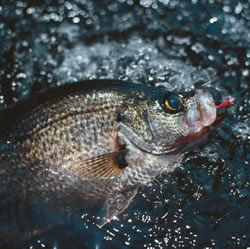
Trophy specs, a.k,a. crappie, are abundant in Lake Santa Fe. |
Mention speckled perch in the Gainesville area and Lake Lochloosa is currently the first lake that comes to mind. Thanks to a massive stocking project, that lake is producing a lot of fish, and some of them are reaching respectable size. Rodman Pool will also get a few votes, and those who stay very current will note that Orange and Newnans lakes are coming back.
Lake Santa Fe seldom makes the list. But, if an incident that happened to me in March is any indication, it should.
It was a warm afternoon, and specks were the last thing on my mind as I worked a gold minnow plug over submerged grass in six feet of water along the northeast corner of the lake. Bass were moving in to spawn, I wanted to get out of the office, and Santa Fe is the closest lake to my house. It seemed like a plan, and I'd already corralled a few small bass when my plug suddenly “got heavy.” As far as strikes go it wasn't much, and when I got the fish to the surface I could see why. It was a speck—but what a speck!
Having spent a fair amount of time chasing specks on Santa Fe over the years I had already discovered that 13- to 15-inch fish were more common than uncommon, and I'd even tallied a few in the 16- to 17-inch range. This one, however, was well out of that class. It measured a bit over 19 inches on my Florida Sportsman Law Stick, and was butterball fat.
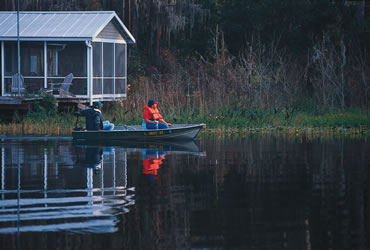
Slipping out on a glassy day on a speck search mission. |
It was by far the largest speck I'd ever caught, and bigger than any of the bass I caught that day. Unfortunately, I'd left my scale at the house and couldn't get a weight, and not wanting to keep any fish on an impromptu afternoon trip I eased it back into the lake and watched it swim off in fine shape. Besides, that fish was likely spawning in that shallow area and I really didn't want to pull those genes out of the pool anyway.
I didn't give the fish much thought (other than “Wow, that was a big speck!”) until I was talking to Gary Simpson at the Tackle Box in Gainesville, a few months later. He asked me how much it weighed and when I told him I had no idea, he sadly informed me that I may have committed a major piscatorial boo-boo. According to Simpson (who is pretty sharp on this stuff) the current Florida state record speck is 3.83 pounds from Lake Talquin in 1992. And, a 19-inch-plus speck in prime spawning condition might—not for certain, but maybe— equal or beat it. In short, Gainesville's resident piscatorial authority informed me that I might have tossed a contender for a new state record over the side.
I've had my share of Homer Simpson “Doh!” moments, but the thought that a new state record might be swimming in Santa Fe surprised the heck out of me. When I discussed the possibility with Florida Fish and Wildlife Conservation Commission (FWC) biologist Jerry Krummrich, however, it didn't surprise him.
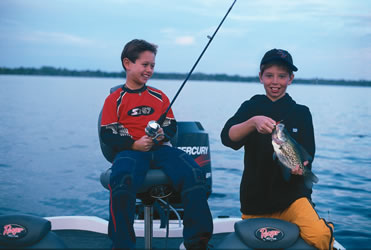
Trevor, left, and Daniel Schultz rake in some speck-ta-cular rewards. |
“Santa Fe isn't as fertile as some of the other lakes in the area and wouldn't carry the poundage of fish per acre that an Orange or Lochloosa would, but it has all the right ingredients to produce big specks,” he explained. “This lake is unusual in that it doesn't have gizzard shad. It's a threadfin shad-only-system. That is an ideal year-round forage base for specks. You also have significantly deeper water. A lot of the lake is over 15 feet deep and there are a lot of 20- to 25-foot depths. The forage and the water depth create an excellent speck habitat that was still great throughout the recent drought. Specks may have struggled on other lakes, but they had an very stable environment here.”
“A good environment is one thing,” he continued, “but a major key in producing big specks is time for the fish to utilize that habitat and grow. It takes about three years for a speck to reach 10 inches. One of 19-inch size is likely to be in the five- to six-year-old class. On a heavily fished lake not many survive that long. You won't have a 15-inch speck if it goes into the skillet at 12 inches. Fishing pressure plays a role and Santa Fe has had very light angling pressure for specks during the last three or four years. A 19-inch speck is a monster speck. But, when you combine the habitat, forage and lack of pressure, it doesn't surprise me that specks of that size are there.”
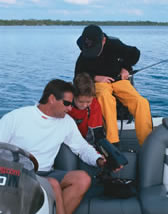
Bernie Schultz scouts for speck schools below the surface with an Aqua Vu camera. |
The specks begin to turn on after the first cool snap in November and stay on the prowl through most of February. However, for those used to chasing specks on shallower lakes, the deeper waters require some adjustment to tactics.
With the exception of an occasional rogue speck that pops a bass plug in shallow water, Santa Fe specks stay deep anytime they are not actually spawning. Over the last couple of seasons, after water levels had risen, the most productive depths have been from 19 to 25 feet. Within that depth range specks may be near the bottom, or suspended midway to the surface, but it has been rare (at least for me) to catch a decent-size speck from water shallower than 19 feet when they are not spawning.
That largely rules out the popular “spider technique” commonly used on lakes with a maximum depth of 10 to 12 feet. On these shallower lakes, a half-dozen canepoles arrayed around the boat can have baits set at different depths, covering the entire water column, and locate the depth fish are using. Twenty-five feet of water is pretty much out of the reach of any canepole I'm familiar with.
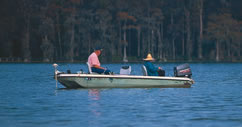
Work the entire water column to find the feeding zone. |
My solution is an unorthodox but very effective rig that lets me cover both the bottom and the mid-depths with a couple of ultra-light spinning rods. I start with a small gold barrel swivel on the main line and tie on 24 inches of fluorocarbon leader in the 12-pound range. Another swivel goes on the end of that, then another 24 inches of leader, then one more swivel, then 12 inches of leader, and a 3/8-inch bell sinker on the end of that. If the day is particularly windy and the drift is fast I'll use a 1/2-ounce sinker. That provides a staging line about the length of the rod.
The fish-catching end of things is a No. 4 gold wire Sproat hook tied onto 10 inches of fluorocarbon with a small, gold snap swivel on the other end. I can clip one of these onto each of the three staging line swivels and have baits spaced two feet apart over a 4-foot distance and far enough apart not to foul.
One rig is always dropped straight to the bottom and slipped into a rod holder. I've found the biggest specks are normally the deepest and that rod usually produces the largest fish. The second rig gets about 12 to 15 feet of line stripped out and goes into a holder on the other side of the boat. That two-rod spacing covers the bottom up to about five feet above and five feet of mid-depth water. That scours a lot of the water column, and normally finds specks fairly quickly. Once I start to pick up some fish and determine whether they are deep or suspended, I can adjust to keep all baits in the “good zone.” If I'm fishing by myself, two rods is about as much as I want to handle, but with an additional angler in the boat you can add another pair and virtually strain the entire water column.
The multiple hooks also give me the ability to see just what the specks want to eat that day. In colder weather I'll slip a Missouri minnow onto one or two hooks on each rig, and add a 1 1/2-inch, soft-plastic tube or paddletail jig to the other. Specks like real meat when it is cold. In warmer weather plastic works just as well with less bother. With the sinker anchoring the end of the rig, jigheads on the baits aren't needed or desired. Plain plastic on the hook will achieve the proper swim speed.
Specks can be pretty color conscious and may even change their color preference over the course of a day, but I have found that by alternating plastics in pearl white, white/chartreuse, pink or black/chartreuse, at least one of those colors will always work.
It's a fairly low-tech system, but it normally finds specks. However, a recent trip with fellow FS contributor Bernie Schultz and his sons Daniel and Trevor, showed me that high-tech can sometimes find them faster.
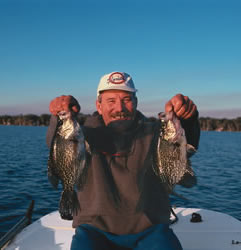
This pair of handsome specks fell for artificial lures. |
In order to keep the kids entertained until we found some fish for them to catch, Bernie brought along the Aqua Vu underwater camera he uses on the professional bass tour. In raising two sons, he's found that children are fascinated by the view of life below the surface. Since I'd caught good fish a few days before in the 20- to 21-foot range, I dropped some rigs down and used the depthfinder and trolling motor to cover that contour line to find them again while Bernie and the boys checked out the subsurface life.
An hour later I was still looking, and in serious danger of losing my “expert” status. So, Bernie decided to terminate the entertainment function of the Aqua Vu and put it to work.
We idled a zig-zag course toward deeper water until we started to see activity on the graph recorder, which we then checked out by lowering the camera. It only took about 20 minutes before we found that the specks had decided to suspend in 10 to 14 feet of water over 24 feet of water on that day. Once we found the fish, it was a simple matter to adjust the depth of the rigs and start collecting a double fish fry's worth of platter-size specks.
I could get to like high tech!
Irrespective of whether one opts for a high-tech or low-tech approach, staying in the 19- to 25-foot depth zone has proven critical for success during the fall and winter months. And, there are more than a few spots on the lake where you'll find that much water.

Contour drops are often the key to locating crappie schools. |
My favorite section is the north end of Santa Fe, from the first 19-foot drop south of the cut to Little Santa Fe, and easing back to the west toward Santa Fe Beach. Another very productive spot is the 20- to 23-foot contour line on the east side of Little Santa Fe Lake. Some long-time lake regulars feel this area is the most consistent producer of big specks.
If the wind is up and causes problems on the open lake, there is a compact 20-foot hole in Bonnet Cove (in the southwest corner of the lake) that is always good for a few fish. Another overlooked speck spot is Melrose Bay in the southeast corner. It's not large and it is all an idle zone. But, even though the available lake maps don't show it, there are depths to 23 feet in there and a tremendous amount of planted brushpiles in the 12- to 16-foot depths. Specks like that, and more than a few call the bay home.
Just how many will scale more than 19 inches is a matter of conjecture. But, I know there is at least one finning around Santa Fe, because I tossed it back.
Three Launch Options
Getting onto Lake Santa Fe is easy, whether you're running a pontoon boat, a kayak, or anything in between. There are three public (no fee) ramps available.
The one I normally use is at Santa Fe Park, on the south end of Lake Santa Fe. This is located just off of SR 26, about 1/2 mile west (toward Gainesville) of the Melrose traffic light at SR 26 and SR 21. It is well marked and hard to miss.
This is an excellent example of public funds going to good use. That ramp has two boat launching lanes, good parking for about 20 rigs, public restrooms and is adjacent to a large (and well-maintained) picnic area. It will handle a full-size pontoon boat. A deputy sheriff lives on the access road, making it a rather secure area.
There is a ramp on the north end, on Little Lake Santa Fe, that takes a little more effort getting to. Located on 21B, this is best accessed by taking SR 21 toward Keystone Heights and turning onto SE 27th St. (next to the Chevron station) following that to 21B (turn right). Turn right again at the STOP/Dead End sign, and then watch for the yellow boat ramp sign. This ramp will also handle pontoon boats, but parking and facilities are more limited than at Santa Fe Park.
If you just want to canoe or kayak your specks, use the special ramp in Melrose Bay. Head a few hundred yards toward Gainesville on SR 26 from the Melrose traffic light and turn right onto Trout St. to find the ramp about 300 yards away. It is limited to boats with 12 hp or smaller outboard motors, and no PWC. All of Melrose Bay is an idle zone, which makes it a good bet for paddle craft; and it hosts some pretty good specks in the deeper portions.
FS
